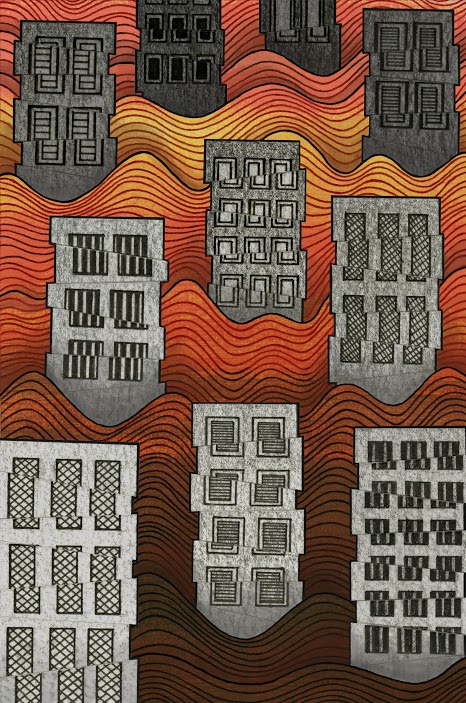SUNDAY, 18 JUNE 2017
At a quarter to three on Friday, 11th March 2011, as the citizens of the Honshu island of Japan were looking forward to the weekend, tectonic stresses caused a massive slip on the ocean floor off the East coast. The sea floor jerked as much as ten metres upward and fiftymetres horizontally. The rupture length totalled 500 kilometres, the width 200 kilometres. If harnessed, the seismic energy from this earthquake could have powered a city the size of Los Angeles for a year. The Tōhoku earthquake measured a magnitude 9.1: it shifted the Earth’s axis twenty centimetres, changing the length of a day by a measurable 1.8 microseconds. 25,000 people died (mostly because of the resulting tsunami), a tragic death toll, but one that only accounted for 0.4% of the population affected by the disaster.In striking contrast, the 2005 Kashmir earthquake measured a magnitude of 7.6, which is 200 times less powerful than the Tōhoku earthquake and yet killed around 90,000 people. In fact, death rates in earthquakes within continental interiors, which are generally around a hundred to a thousand times less powerful, often exceed 5%, and can be as high as 30%.
 Nina Capes
Nina CapesAssuming the Japanese do not somehow have a natural resilience to earthquakes, there must be a reason why cities located far from subduction zones (like those on the East coast of Japan, which produce the largest and most frequent earthquakes on the planet) experience such a greater impact. What were cities in Kashmir less prepared in Tōhoku?
The Japanese have spent a lot of time learning how to anticipate earthquakes – but so have Californians. These communities sit near boundaries between the tectonic plates comprising the Earth’s crust and upper mantle, where a great deal of tectonic activity is observed and expected. The same is not true if you live in the middle of a plate, or far from obvious zones of tectonic activity. Intraplate earthquakes are far less frequent and much more difficult to predict. The bending of rock that occurs before an earthquake can take place over timescales as long as tens of thousands of years – longer than human civilisation has existed. Since we have never seen them slip, the location of many intraplate fault lines’ is hidden to us. Researchers continue to search for the causes of these earthquakes, and especially try to find out how often they recur. This requires dense arrays of expensive seismometers that are difficult to put in place in some of the less developed regions of the world, the very same regions often at the highest risk of intraplate earthquakes.
Finding fault lines is not the only problem, however. In the Middle East and surrounding areas with arid climates, you will often find cities built on recently discovered fault lines. This is not mere coincidence. The vertical slip on these faults actually raises the water table nearer to the surface, which attracts unwitting settlers. Since many of these regions have no history of earthquakes, today’s inhabitants often build their houses out of stone and concrete, which are cheaper and more abundant. This is an unfortunate recipe for tectonic disaster. When an earthquake does hit, these brittle houses collapse easily, virtually turning to rubble on shaking. Collapsing buildings kill people, more than anything else in an earthquake.
The issue is also political. Nicholas Ambraseys and Roger Bilham, from Imperial College London and the University of Colorado respectively, calculated that 83% of all deaths from building collapse during earthquakes over the past 30 years occurred in countries that are anomalously corrupt. Such countries see funds provided to prepare for future seismic events siphoned off towards ‘more pressing’ projects, such as those important for reelection. Corruption, quite literally, kills.
 A region’s vulnerability to earthquakes has little to do with the frequency of earthquakes occurring there. For areas where earthquakes do occur, but are rare and unpredictable, the problems are manifold. Even if the active faults are found, providing funding and expertise for preparation is problematic because of corruption and how difficult it is to predict the recurrence of these quakes. Convincing politicians and citizens that it is worth investing in preventative measures over other issues such as healthcare or housing therefore becomes a complicated task. To top it all off, existing housing in developing regions is often exactly the opposite of what an earthquake resistant design would prescribe.
A region’s vulnerability to earthquakes has little to do with the frequency of earthquakes occurring there. For areas where earthquakes do occur, but are rare and unpredictable, the problems are manifold. Even if the active faults are found, providing funding and expertise for preparation is problematic because of corruption and how difficult it is to predict the recurrence of these quakes. Convincing politicians and citizens that it is worth investing in preventative measures over other issues such as healthcare or housing therefore becomes a complicated task. To top it all off, existing housing in developing regions is often exactly the opposite of what an earthquake resistant design would prescribe.Dr. Emily So, Senior University Lecturer in the Department of Architecture, Fellow of Magdalene College, advises on how cities – particularly those less financially able to provide for themselves – can prepare for earthquakes. “Awareness is key,” says Dr. So, who also leads the Cambridge University Centre for Risk in the Built Environment.
“Like other public health campaigns in the past where diseases have been eradicated, earthquake protection needs to be seen as a public health issue.”
Dr. So suggests that a staggered approach to earthquake proofing is a method of saving lives while keeping costs down. “Earthquake proofing and building codes have different design levels. Nuclear power plants for example, are designed to withstand very large events with no damage as the consequences do not bear thinking about. “On the other hand,” continues Dr. So, “life safety may be the level at which residential housing in developing countries could be designed to.” Houses can be built so that while they feel the effects of an earthquake and become damaged, they will not fall apart, collapse and kill people. Such houses could need repairs or partial reconstruction after a large earthquake. However, it would still be cheaper than clearing the foundations of houses not built in this way and rebuilding them from the bottom up.
How can the suggestions of researchers like Dr. So be implemented? Both in Cambridge and beyond scientists and engineers are involved in various steps of reducing the risk, and ultimately the death tolls, of these disasters. Geologists play a vital role in identifying faults that are likely to rupture in the future, not by turning their heads to the ground but to the skies instead. Satellite data is incredibly valuable in tracking the slow bending of the rocks surrounding fault zones. Due to the motion along a fault, the satellite will detect the ground as being farther away, or closer, than it was on previous passes. Tell-tale signs of past events may also be preserved in the landscape, for example, earthquake-induced landslides.
While this does not allow geologists to definitively predict an event will occur, they are able to suggest likely locations and magnitudes of future earthquakes. This can be used to create the political pressure necessary to take action, such as enforcing regulation on construction, and raising public awareness. In this way, the knowledge that underpins successful earthquake resilience in communities in Japan, California and Chile can be extended to other areas.
Finally, housing must also be improved. The cities of the future may in fact be moving away from modern construction techniques, says Dr. So. “[Collapsed buildings are] one of the main “killers” in earthquakes.
In recent years, we have seen more and more shoddy ‘modern’ buildings, built without correct code enforcement, collapsing. Communities in the developing world want to use modern engineered materials, but without the engineering input, these become dead weight and dangerous. We must find new ways of making traditional, vernacular [designed based on local need] forms of construction into attractive alternatives.”
Hopefully, through the cooperation of researchers and engineers across many disciplines, we can understand more about the mechanism of these devastating earthquakes, raise awareness, and begin to resolve the international discrepancy in earthquake preparedness. Strong political action, as well as good engineering and careful planning will be required to ensure cities across the world improve their structures and infrastructures for a disaster-proof future.
Image Credit: Hitchster
